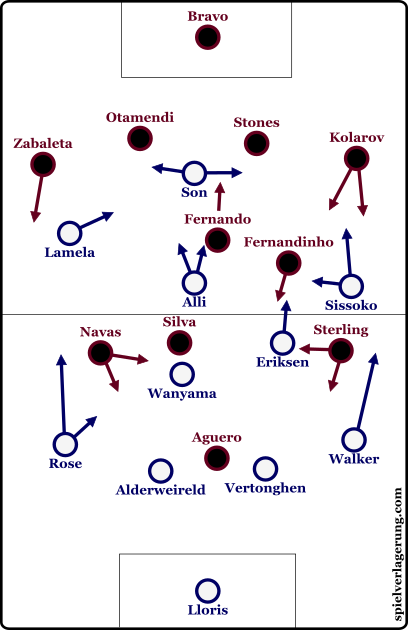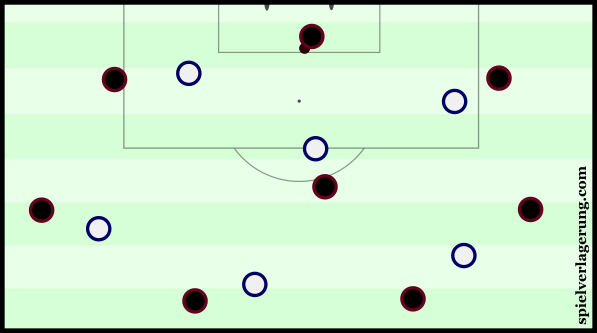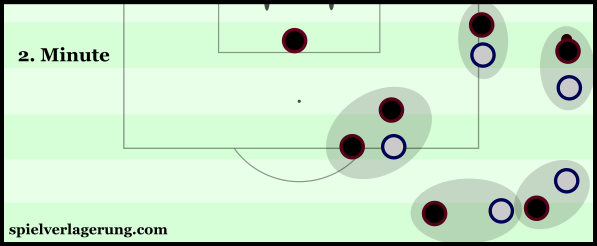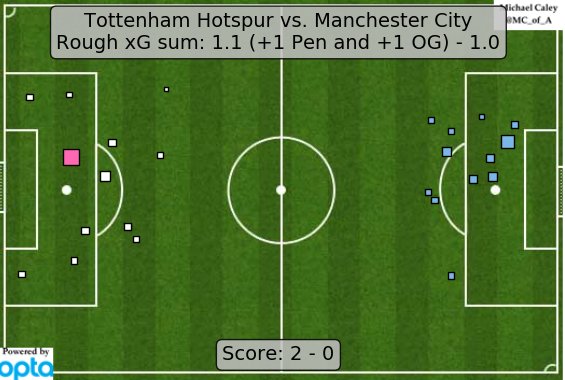Spurs’ pressing registers first City defeat
After Brendan Rodgers’ Celtic challenged City with their pressing game in the midweek draw, Pochettino’s Spurs took full advantage and clinical first-half finishing saw them administer the first defeat of Pep Guardiola’s City reign.
Both managers made interesting changes to their line-ups.
For the home team, we saw Christian Eriksen in an unusually deep position alongside Victor Wanyama. £30m (thirty million pounds) signing Moussa Sissoko played on the right side of the midfield, and would move towards the centre whilst Lamela was more of a traditional winger. The selection of Son Heung-Min as the striker would prove to be an excellent choice, as the South Korean led his team both in the pressing and in the quick attacking.
Without De Bruyne, Guardiola had to make changes of his own. Fernando came into the midfield after the Belgian’s injury, whilst Jesus Navas started too. Through the change of players, City resembled more of a 4-2-3-1 as opposed to the 4-1-4-1 we’ve seen them so far, Fernandinho played closer to Fernando whilst Silva acted between the lines higher up.
Spurs’ Pressing
By far the biggest talking point in the battle between Pochettino and Guardiola, was the former’s pressing approach to the game. One of the more notable ‘disciples’ of Bielsa, Pochettino has instilled an aggressive defensive approach at White Hart Lane as he had once done at St. Mary’s and at Espanyol before then. Capable of a press which has caused many opponents issues in the past, the young team were a prime candidate to be Pep’s biggest challenge yet, and they clearly were.
In typical ‘Bielsista’ fashion, Spurs were once again man-oriented in their pressing of City’s first phase. The two highest players, Alli and Son, would often split onto either centre-back and Christian Eriksen would move up to cover Fernando in the defensive midfield position. From this starting shape, the forwards would then use their cover shadow to block passes whilst pressing Bravo, with the intention of forcing an error from the goalkeeper.
Behind them the wide midfielders, Sissoko and Lamela, would support the press. The ball-near winger would often cover the full-back with the possibility of moving higher to increase the pressure whilst the ball-far winger came inside into a central City player. Although this strategy left Wanyama with a large amount of space to cover, he did so fairly well and made the tackle to win possession before Kolarov’s early own-goal. At times he was aided by the ball-far winger, or even the full-back who would sometimes come inside to help win balls. Sissoko was particularly able to shift inside to support due to the inside nature of Kolarov, who played as a ‘false’ full-back once again.
As is normal with a man-to-man approach, Spurs’ structure varied between plays. It was reactive to the shape of City which mean that Alli could sometimes drop into midfield for example, but the 4-1-2-1-2 shape was apparent.
Almost every turnover was matched by an intense counterpress from the home team. Even if the distances were too far to make an ideal counterpress, they would rush forward in a man-oriented manner and challenge Manchester City through the intensity of their movements. The intentions of Spurs’ approach in transition was to make the start to every oppositional possession as chaotic and unclean as possible.
The host’s pressure was effective in disrupting City’s build-up and the entire possession game as a whole. Pep’s team were forced into a number of long balls and possession was lost frequently without an attack formulating. Although City have obviously made some great performances in the start to the season, but their possession game is still very much in early development. Their understanding of Guardiola’s system is improving with every day, but the players are still learning as they would be under most coaches, thus it was little surprise to see the second-best pressing team in the league cause them issues. This is especially the case when Fernando and Navas started – two players who haven’t had a lot of playing time in Guardiola’s first three months.
After taking the lead, the pressing subsided to some extent. It’s most likely that this was a result of a lead to protect, and for energy conservation as the intensity of the movements dropped.
City’s issues in possession
Against Tottenham’s pressure, City showed some clear issues in their possession game.
During build-up, they would often go directly to the strikers. In some cases, this was even when Spurs’ pressure wasn’t causing any danger, which suggests that a part of Guardiola’s plan was to bypass the pressing through a direct play, as he had done on occasion at Bayern. However, this time it wasn’t as successful. Agüero was obviously the main target for these long balls, who is much less capable of attacking in this manner in comparison to Lewandowski, and neither Navas nor Sterling got into positions close by for the purpose of supporting on the second balls.
With this direct play, there was less of an emphasis on a well-connected structure in the first phase.
After around the opening 25 minutes, City benefited from some attacks down the left side of the pitch. Sterling was moving inside whilst Silva would shift across to interact with Fernandinho, and the trio (as well as other teammates situationally) were able to make some combinations against Spurs’ strong midfield pressing. In addition, Silva was able to find gaps of space against the pressing which was at times uncompact due to the man-orientations. The inside movements of Navas and Sterling allowed City to overload Wanyama, which would result in one of the players (preferably not Navas) becoming free.
In other cases, the centre-backs could help break Spurs’ man-oriented approach through individual dribbling. Obviously a high-risk approach, due to the dangerous position of losing the ball, both Stones and Otamendi could look to move past their presser to help move the ball forward. Due to the nature of Spurs’ man-to-man approach, every player was quite focused on covering their own man. That meant that if a player is beaten, then there is little cover to pick up the now-free man. If someone does move out to cover the ball-carrier, then it could easily result in a free player being available elsewhere, and it could continue so forth.
Despite improving, City were still unable to register big chances against Hugo Lloris. In some situations, an individual would be wasteful and take a low-percentage shot, when a pass would’ve created a more threatening moment. In others, the attacks simply broke down on the 3rd or 4th pass of a combination with the two centre-backs defending particularly well. When they found space between the lines, Jesus Navas was a common recipient of the pass.
The Spaniard is far from Kevin De Bruyne, and he was unable to convert these moments into strong attacks. Upon receiving the ball, he often missed a good passing opportunity to further continue the possession and instead looked to carry the ball, which was often met by good pressure from Spurs. This slowed down the attack in most occurrences, and it allowed Tottenham to recover and close out the previously-available space.
However, through these openings, City forced Tottenham into a deeper block. They shifted their focus to more of a midfield press and the centre-backs were then under less pressure during build-up. This benefited Guardiola’s team, who were then able to start attacks from higher up the pitch, giving them a better opportunity to penetrate the midfield through overloads, as both the wingers and full-backs came inside at times.
After half-time, Ilkay Gündogan was introduced as Guardiola probably looked to build-up on their improvements in midfield. The former BVB playmaker is an excellent box-to-box player whose ball-carrying skills and pressing-resistance could’ve been especially important against the man-to-man pressure of Spurs. It would hypothetically allow him to break the press through beating his man in a 1v1 as I mentioned with the centre-backs above.
Yet he had quite a poor game, and made three turnovers within the first few minutes of his introduction. The weighting of his passes were particularly disappointing, with a number being either under or over-hit.
A more Equal Game than Suggested
Pochettino’s team were the better of the two, and were on-top for larger periods of the game, yet the game was more balanced than many made it out to be. By both Michael Caley and 11Tegen11’s expected goals model suggested a fairly close game, with Spurs still edging it of course. Especially as the second half progressed, City were able to create a couple of good chances through Agüero and Iheanacho but they simply couldn’t convert these opportunities past Lloris.
For periods, City pressed in Tottenham’s third just as well as the hosts had done to them. Their zonal block gave them good stability although they struggled at times to deal with the vertical combinations which Pochettino’s side used to advance the ball and maintain the high tempo of the game.
Still, this isn’t to take anything away from Spurs, whose pressing game has been the first to nullify an on-fire City attack. Their pressing both high up as well as in their own half worked to disrupt and weaken City’s possession game which is still in development under Guardiola. Heung-Min Son was particularly good for the hosts. He held the ball up well, and brought other attackers into play whilst his movement into the channels (particularly to the right of Otamendi) was useful for creating space and advancing the ball directly too. The visitors clearly lacked Kevin De Bruyne to penetrate the midfield lines whilst the omission of both Gündogan and Sané from the starting eleven was questionable.
It will be interesting to see if teams follow the approach of Spurs when facing City after the international break. There are few teams in the league capable of pressing with such intensity and control as Pochettino’s side, and an uncoordinated attempt will certainly play into the hands of Pep.








5 Kommentare Alle anzeigen
Jonh Card October 5, 2016 um 8:55 pm
Great analysis as usual, but what strategy would you use in this game to surpass Tottenham pressing?
Thanks and keep up the excellent work.
Bowser October 7, 2016 um 12:35 pm
I’m not an expert, but I believe that in order to beat a man oriented pressing/defensive scheme then positional & player rotation are key. Also, like mentioned in the article, players such as Ilkay Gündogan who are great at resisting pressing and can frequently dribble past opponents would help to beat the press as if they bypass their opponent they become the free man and force opponents other than his own marker to leave their assignments.
Danny October 5, 2016 um 11:03 am
Agreed with the analysis, but when watching, it just didn’t seem like Spurs were ever in danger of conceding. Despite Tegen 11’s stat analysis. I thought City came back into the game before half time, but in the second half; Spurs just looked in control. City’s record without KDB increasinly gets worse, as well. He may be the league’s most valuable player.
Barun Saha October 4, 2016 um 11:51 pm
Thanks for the analysis TP. It was great as usual.In my humble opinion spurs played with much more passion; intensity; tenacity and heart compared to city. It was much more than just tactical reasons why spurs were winning every duel on the pitch. I would also like to highlight a few things
Firstly; it was a mistake from pep not to buy a couple of decent full backs who have got age on their side.
Secondly; the failure to convince bonuchhi could prove really costly as company is as always hopelessly injured.
Thirdly; failure to buy a tall striker who could offer something different… Especially in the air.
And lastly should have gone for a little more experience for winger positions rather than completely relying on unproven talents.
Take care… Bye.
Danny October 5, 2016 um 11:05 am
I think he’ll address the fullbacks in the next window, or summer. As for Bonucci – we don’t know his state do we; he might not be willing to move away from Turin, his family might want to stay, he doesn’t speak English, wants better weather etc. Obviously a great player, but there’s more to it.